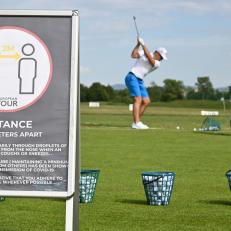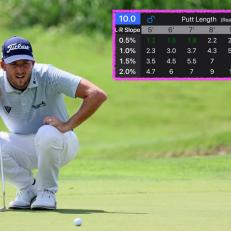The New Tour Swing: How It Works
By
Andy Plummer and Mike Bennett
Photos by
J.D. Cuban
January 06, 2010
Setup
Picture two points, one midway between the shoulders and one midway between the hips. These are the swing centers, and they should be stacked, setting the spine vertical. The grip is neutral, the weight 60-40 on the front foot.Here Aaron is hitting a 5-iron, so his ball position is just ahead of the middle of his stance, directly below the centers. This over-the-ball posture pre-sets a rotary swing with no shift to the back foot.
Halfway Back
The spine tilts toward the ball at address, and when the player swings back, that tilt moves to the right. So to keep the spine over the ball, which is the goal, the player has to tilt to the left during the backswing. The first move going back is this tilting action. It causes the shoulders and hips to turn on a steep downward angle, the right leg straightening and the left knee flexing forward.As the left shoulder turns down, pointing almost to the ball, the hands move on a circular arc around the body, not up and away, and the arms stay on the rib cage. When the left arm reaches parallel to the ground, it should be angled 40 degrees inside the stance line. To golfers who've been told to swing back along the target line, this will feel way too far inside.
What It Feels Like
The hips are level at address, but because the spine tilts toward the target going back, the right hip turns much higher than the left. It should feel as if the right hip is moving up and behind the body.At the Top
The spine should be vertical at the top, which makes the player feel tipped over the front leg. This tilting toward the target happens continuously during the backswing. At the top, the weight on the front foot has increased slightly.The upper body is now full of torque but remains straight up and down—picture the twisted double helix of DNA from high school biology. Here Aaron is tilted a few degrees to his left, which is the feeling a player should get. The arms stay low and inside, because they're moved by the rotary motion of the body; no lifting off the rib cage. The head stays in place, so the ball remains centered in the player's vision. If the head shifts, it has the same effect as the ball moving and inhibits solid contact.
What It Feels Like
Imagine you're making a left-handed follow-through. Grip the club like a lefty and swing through, feeling how the right side stretches and the spine tilts back. Then take your normal grip and feel that same stretch on a right-handed backswing.Halfway Down
The entire body starts the downswing together. More weight immediately moves to the left foot, with a distinct leaning into the left knee. Remember, the priority is to get the swing centers in front of the ball at impact. The hips start to turn back to level, and the legs reverse roles, the left leg straightening and the right leg flexing.The turning body is supplying the initial acceleration, so the player must maximize rotational speed. The hips have limited turning capacity when they're tilted, so they have to come out of their tilt to keep accelerating. The move that releases the hips is a springing up of the lower body, where the butt muscles push the hips upward and toward the target. The player has to feel as if he's jumping up as the club comes down.
What It Feels Like
As you start down, imagine you're crushing a soda can under your left foot. The body has stayed centered on the backswing, so there's no need to shift back to the ball. This downward pressure on the left foot sets up the upward thrust of the hips through impact.Impact
The upward thrust of the lower body that releases the hips—notice here the leg and butt muscles pushing forward—also helps deliver the club to the ball. Because the body is leaning on the front side, the club comes down steeply and will crash into the ground unless the swing shallows out. The pelvic thrust takes some of the steepness out of the swing.The upper arms stay on the rib cage, and the hand path comes from well inside. The pelvic thrust allows the hips to keep turning, which keeps the clubface closing at a constant rate and the hands swinging on a circular arc. The club releases without any conscious hand or arm action. At impact, the swing centers are in front of the ball, so the club catches the ball first then cuts a divot.
What It Feels Like
Football kickers know they get more power if they swing their leg on an arc. Angular momentum (arc) beats linear force (straight line) for distance. Same goes here: The hands swing fastest when they approach from the inside.Finish
With the hips released toward the target, the torso flexes forward and the butt tucks under the back. Notice the spine tilts away from the target for the first time. The belt is level and several inches higher than it was at address.As the torso stretches, the arms can extend and the hands don't drop over the left shoulder. The hips and shoulders have continued to turn toward the target. As the club re-cocks, forming a 90-degree angle with the forearms, the speed of the through-swing is absorbed. The hands are still swinging on a circular arc, because the body has kept up its speed. The so-called release is the body releasing from its forward tilt, not some manipulation by the hands and arms.
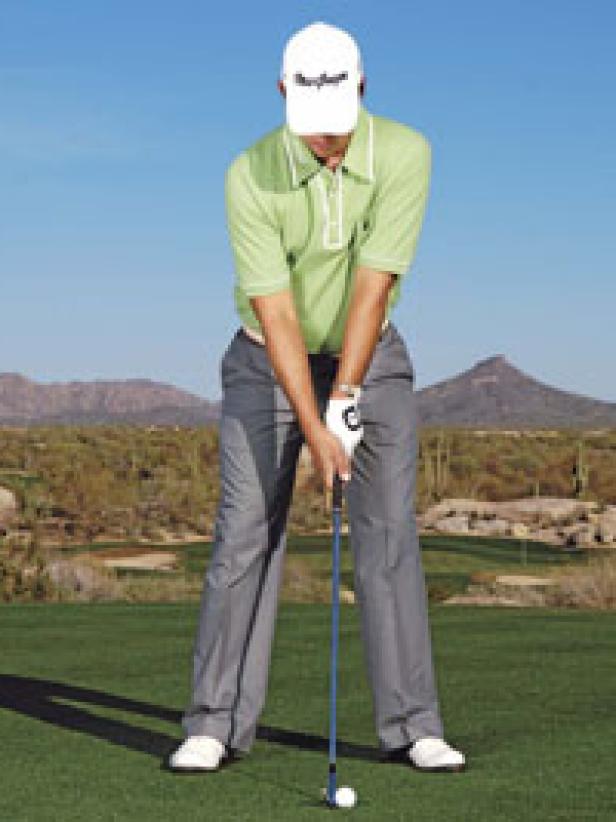
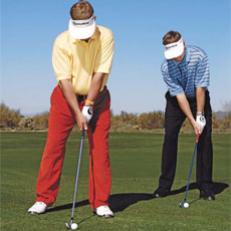
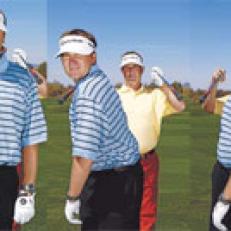


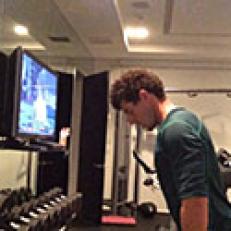
) and Charles Howell III look so effortless when they swing. For them, the club, arms and body move in sync. By starting right, you can have that, too.](http://golfdigest.sports.sndimg.com/content/dam/images/golfdigest/fullset/2015/07/21/55ad99acadd713143b437df2_instruction-2007-11-inil01_andrews.jpg.rend.hgtvcom.231.231.suffix/1573467010575.jpeg)




